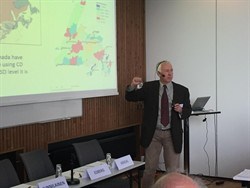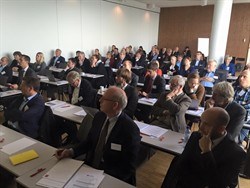Second OECD study mission: Infrastructure and accessibility in regional development
In the beginning of October, the OECD experts carried out the second study mission of the NSPA Territorial Review process in northern Norway, with a final joint seminar in Kirkenes.
On Thursday 1 October the NSPA network arranged a seminar in cooperation with the OECD as a part of the territorial review of the NSPA area being conducted 2015-2016. The seminar was held is Kirkenes and wrapped up the OECD-team's visit in northern Norway. The overall theme of the seminar was infrastructure and accessibility in regional development. All presentations can be found on this link


David Freshwater, professor at Memorial University of Newfoundland, opened the seminar and the first panel which focused on the role of infrastructure, by highlighting that the most important aspect of peripherality is in the minds of people. When a place is perceived as remote and disconnected from the rest of the world, it will be harder to attract entrepreneurs and to link the local economy with global markets.
Torbjørn Naimak, regional director of Norwegian Public Roads Administration, illustrated how the Norwegian government is shrinking distances in northern Norway through new infrastructure links.
Hanne Junnilainen, Regional Council of Lapland, showed the result of a comparative study of regional airport usage in Sweden, Norway and Finland and pointed out the large impact regional airports have on the local economy, especially in remote areas.
Mårten Edberg, strategist on infrastructure at Region Västerbotten, showed the importance of the Bothnian Corridor for the entire NSPA-area. He argued that internal linkages within the NSPA-area are as important as external linkages, in order to create a common market that can attract investors for other activities than raw material extraction.
Stig Nerdal, Transport Development, pointed out that while the transport systems work well within the Nordic countries and Russia, obstacles at the borders remain especially for goods transport as border crossings are not always open and railway systems have different specifications.
The second panel focused on accessibility and connectivity in remote areas. Rune Dahl Fitjar, professor in innovation studies at the University of Stavanger Business School, started the second panel by arguing that transport infrastructure bottlenecks are not the only barriers to interconnectivity. For the peripheral regions, there lies more potential in developing connections to global hubs of innovation rather than increasing connectivity between firms and institutions in the local area.
Hans Dunder, economic development officer at City of Sundsvall, illustrated how smart infrastructure investment can have quick payoff even in sparsely populated areas, with the example of the remote airport tower centre in Sundsvall.
Sveinung Eikeland, vice rector at the University of Tromsø showed that in Norway, the direction of migration is towards knowledge hubs and as such regional universities are very important. Moreover, skilled labour in northern Norway is to a very high degree educated in northern Norway.
Tove Sørensen, manager at the WHO collaborating centre for telemedicine and e-health, showed the challenges of providing accessible health services in northern Norway, and the long engagement with telemedicine in the region.
The third and final panel focusing on regional competitiveness was opened by Andrew Copus, economic geographer at James Hutton Institute and Nordregio, who highlighted smart specialization strategies as a good way for the NSPA to use its particular strengths and characteristics within the framework of European regional development policy.
Knut Onsager, senior advisor at the Norwegian Ministry of Local Government and Modernisation, described the main aspects of the Norwegian regional policy, which aims to maintain the existing habitation patterns throughout the country through redistribution and investing in infrastructure and competitiveness enhancers.
Målfrid Baik, strategic marketing director at Norut Northern Research Institute, warned against the centralizing tendency within innovation policy in Norway as this trend risks losing the potential growth in the NSPA.
Hans Hedlund, member of the regional committee of the County Council of Västernorrland, described the regional innovation ecosystem in Västernorrland and how the county tried to help companies to access Swedish and global markets through providing physical space in Stockholm, Berlin and Riga.
Risto Poutiainen, regional development director at the Council of North Carelia showed that triple helix cooperation is well-established in eastern and northern Finland. Nevertheless, these regions still compare poorly to the rest of the country in terms of attracting European innovation funding.
Joaquim Oliveira Martins, head of the OECD regional development policy division, concluded the seminar by highlighting the specific problems of the NSPA region being specialized in tradable goods. Competitiveness in the tradable goods markets requires productivity improvements, and the NSPA has been successful in achieving this through innovative methods. However, productivity improvement does not generally contribute to job growth, which means the NSPA has to focus on the areas in which it has absolute competitive advantages and target global markets to reach growth.
The third and final seminar will be held in Sweden in February 2016.
